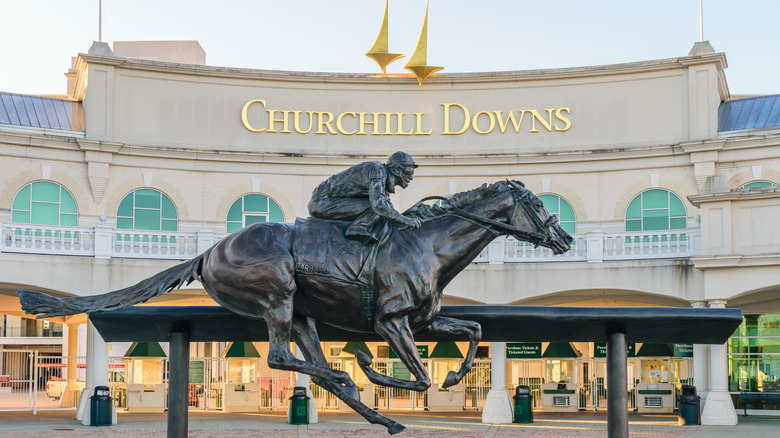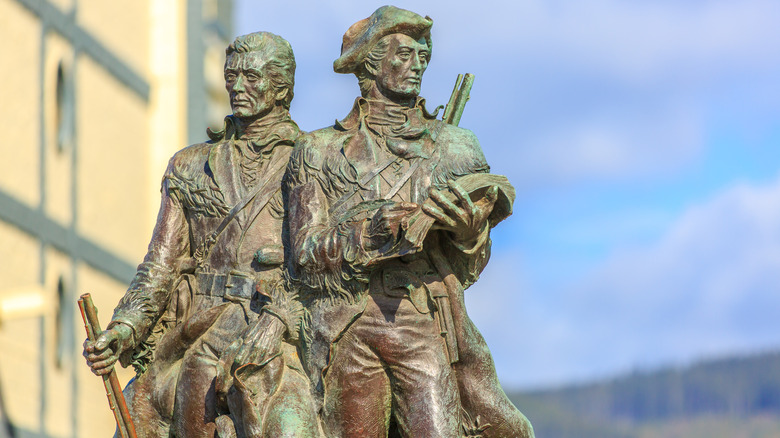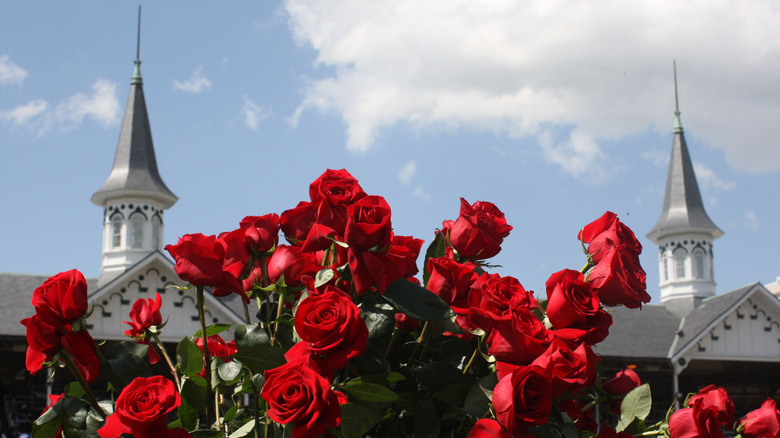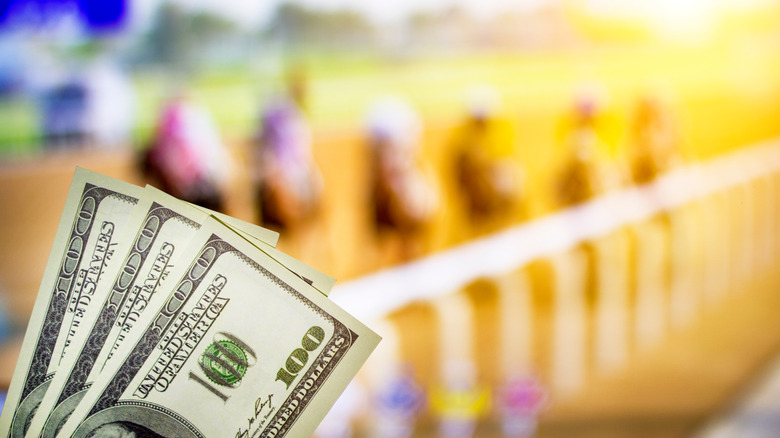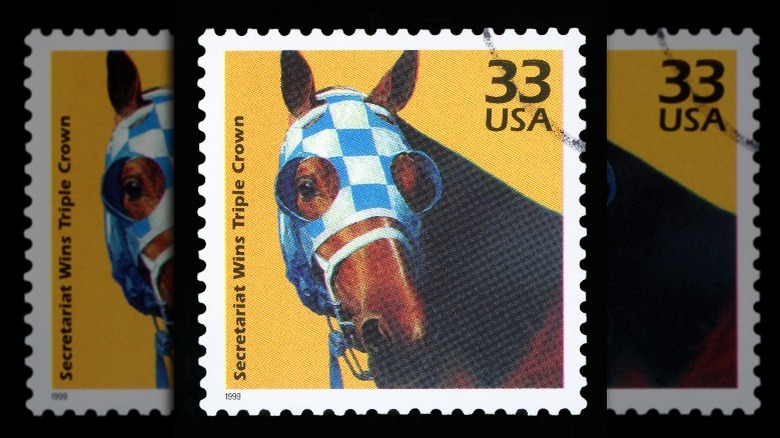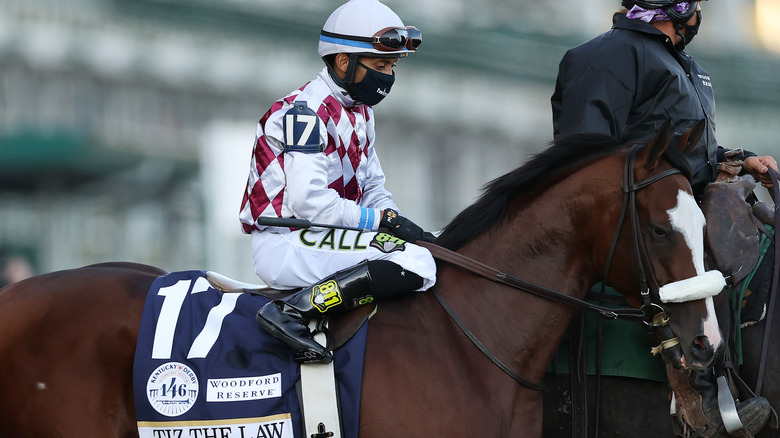The Untold Truth Of The Kentucky Derby
The Kentucky Derby is called the greatest two minutes in sports, which for sports enthusiasts, is the beauty of it. Admit it, unless you're a true football fan AND your team's in the Super Bowl, it's hard to stay riveted to each and every moment of the action. What makes it worse is that you just know that a game-changing play is going to occur when you're in the kitchen grabbing another beer out of the fridge (or in the bathroom making room for more beer). With the World Series, you never even know whether you're going to be committing yourself to four games or seven, much less which of nine innings will see that all-important home run that ultimately determines which team takes home the Commissioner's Trophy. When it comes to watching the Kentucky Derby, though, all you've got to do is focus your attention on the screen for less time than it takes to check your Twitter feed and boom — history's been made.
Even though the actual event is a blink-and-you've-missed-it affair, it nonetheless comes with nearly a century and a half of tradition behind it. While you may think you know the basics (speedy thoroughbreds, big hats, mint juleps), here are a few slightly more obscure facts about the Run for the Roses to help you prep for the big day (or 1/720th of a day, to be more precise).
The founder of the Kentucky Derby had a famous grandfather
The man who established the Kentucky Derby back in 1875 was one Meriwether Lewis Clark Jr. Does the name sound familiar? Well it should, because his grandfather, William Clark, went on an early 19th century road trip with best bud Meriwether Lewis and basically "discovered" the entire United States territory west of the Mississippi (which came as news to the Natives who were already living there, but that's a history lesson for another day).
At any rate, according to Britannica, the younger Clark also got the travel bug, only instead of heading west, he went to Europe. There, Clark hobnobbed with the big names in the horse racing industry, and upon returning home he convinced his uncles, John and Henry Churchill, to let him build a racetrack on their land (the track that now bears their name). On May 17, 1875 the first Derby was run and won by Aristides, a horse who'd likely been named for a statesman of ancient Athens (via World History Encyclopedia).
This is why the Kentucky Derby is also called the "Run for the Roses"
If you've ever wondered why roses are the official flower of the Kentucky Derby, it's not because they bloom in profusion in Louisville, Kentucky at this time. According to Kentucky rose grower Monty Justice, roses in Kentucky typically do not bloom until early June. The rose is said to have been adopted by Meriwether Lewis Clark Jr. as the official symbol of his not-yet-classic race in 1883. Town and Country noted that Clark went to an after-party where trendsetter E. Berry Wall, an influencer 100-plus years before social media existed, was handing out roses to all the ladies he could see.
In later years, the winner of the race would be awarded with a garland of roses, which today is a 40-pound blanket containing 400-some roses that is hand-stitched together at a local Kroger. The nickname "Run for the Roses," however, was not adopted until 1925, when sports columnist Bill Corum coined the phrase (via ESPN). Race officials must not have minded the moniker, though, since Corum later served as president of Churchill Downs from 1950 to 1958.
All of the horses in the 1892 Kentucky Derby finished "in the money"
In horse racing, as SB Nation noted, the term "in the money" usually refers to the top three finishers: the horses who win, "place" (come in second) or "show" (finish third). In 1892, each and every horse in the Kentucky Derby took one of the top three spots. How did this happen? Because only three horses ran in the race.
According to Kentucky Forward, the winner — a horse named Azra — beat out the second-place finisher by a nose. The interesting thing is, while Azra was fairly well known at the time, the number two horse, Huron, was a total unknown. Both horses, however, had the same owner, a man named Ed Corrigan. Six lengths back in third place was a horse by the name of Phil Dwyer. One more fun fact about the 1892 Derby: as Town and Country noted, the jockey atop the winning horse — 15-year-old Alonzo Clayton — was the youngest-ever jockey to win that race, a record he is likely to retain.
A horse with an "S" name is seen as a good bet
Since 1875, there have been 146 horses to take home that Garland of Roses, or whatever the early winners received as their reward (maybe a bouquet of carrots if they were lucky). Of these horses, 19 of them (13%) have had names starting with the letter "S" (via Kentucky Derby): Spokane, Sir Huon, Stone Street, Sir Barton, Shut Out, Swaps, Secretariat, Seattle Slew, Spectacular Bid, Sunny's Halo, Swale, Spend a Buck, Sunday Silence, Strike the Gold, Sea Hero, Silver Charm, Smarty Jones, Street Sense, and Super Saver. Of these horses, Sir Barton was also the first-ever Triple Crown winner in 1919, before the term had even been coined (via Belmont Stakes). Seattle Slew also took the Triple Crown in 1977, while Secretariat – the 1973 Triple Crown winner — made ESPN's list of the greatest athletes of the 20th century.
Not a fan of the letter "S"? "A," "B," and "C" names also tend to do well. "B" and "C" named horses have won the Derby 13 times apiece, with two "C" named Triple Crown winners (1943's Count Fleet and 1948's Citation). While "A" horses only account for a dozen Derby wins, they number 3 Triple Crown champions among their ranks: Assault in 1946, Affirmed in 1978 (the 1940s and 1970s were both great decades for horse racing), and the most recent horse to publication date to win all 3 races, American Pharaoh in 2015.
Never pick the horse who draws Post 17
While Town and Country relates that Post No. 1 has earned the nickname, "The Dreaded Rail" — due to the tendency of horses running from this position to become boxed in by other horses — it turns out that position is not the kiss of death. According to America's Best Racing, there have been eight Derby winners to date to take off from the first post. In fact, as Aspire Mountain Academy points out, a horse on the inside rail (where the first post is located) has a slightly shorter distance to travel, so perhaps this helps compensate for some of the boxing-in effect. The only two post positions with better numbers are Post No. 10 (nine winners) and Post No. 5 (10 winners).
Posts closer to the outer rails tend to do the worst, with just one win each for Posts No. 19 and 20 and 2 wins for Post No. 18. The one post position that could be said to carry a curse (for whatever unknown reason), however, is Post No. 17: not one single winner in 146 years. Of course, by that logic, they're about overdue for a win, wouldn't you think?
